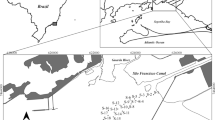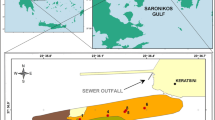Abstract
Over the last century, discharge of industrial effluents and municipal wastewater have contaminated the Lachine Canal sediments. This study investigated the associations between heavy metals and natural sediment constituents. X-ray Diffraction, Transmission Electron Microscopy and geochemical analysis revealed that the sediments consisted mainly of silt and clay size fractions composed of: feldspar, illite, kaolinite, chlorite, calcite and dolomite as well as minor amounts of Fe minerals. Organic matter and amorphous metal oxides were also identified. Each of these constituents bound heavy metals at varying degrees as assessed by a sequential chemical extraction (SCE) protocol. The associations with each geochemical phase were (in order of decreasing significance): 1) residual phase, 2) oxide phase, 3) carbonate phase, 4) organic phase and 5) exchangeable phase. According to the cation exchange capacity (CEC), carbonate and oxide content measurements, the heavy metals occupied a minor fraction of the total capacity of the sediments to retain metals by these mechanisms. The SCE results revealed that the partition patterns varied with pH. The phases associated to the carbonate and the exchangeable phases were the most sensitive to a change in pH with the residual phase being almost unchanged. The Zn and Cd were sensitive to release when the conditions drifted to acidic conditions. The partition patterns for various grain size fractions (<53 µm, 53–75 µm, 75–175 µm and <175 µm) revealed that no particular fraction accumulated a certain heavy metal. Finally, from protocols, techniques and results interpretation in this study, various engineering applications such as the technical choice of clean-up scenarios, screening of remediation techniques and the development of remediation quality criteria were proposed within the framework of the management of contaminated sediments.
Similar content being viewed by others
References
Allan, R. J.: 1986, ‘The Role of Particulate Matter in the Fate of Contaminants in Aquatic Ecosystems’ Scientific Series No. 142, Inland Waters Directorate National Water Research Institute Canada Centre for Inland Waters, Burlington, Ontario.
Beckett, P. H. T.: 1989, ‘The Use of Extractants in Studies on Trace Metals in Soils, Sewage Sludges and SludgeTreated Soils', Advances in Soil Sci. 9, 144–168.
Belzile, N., Lecomte, P. and Tessier, A.: 1989, ‘Testing Readsorption of Trace Element During Partial Chemical Extraction of Bottom Sediments', Env. Sci. Technol. 23, 1015–1020.
Benjamin, M.M. and Leckie, J. O.: 1981, ‘Multiple Site Adsorption of Cd, Zn and Pb on Amorphous Iron Oxyhydroxide', J. Colloid Interface Sci. 79, 209–221.
Calmano, W., Hong, J. and Förstner, U.: 1993, ‘Binding and Mobilization of Heavy Metals in Contaminated Sediments Affected by pH and Redox Potential', Wat. Sci. Tech. 28, 223–235.
Campbell, P. G. C. C, Lewis, A. G., Chapman, A. A., Fletcher, W. K., Imber, J. K., Luoma, S. N., Stokes, P. M. and Winfrey, M.: 1988, ‘Biologically Available Metals in Sediments', National Research Council of Canada, Associate Committee on Scientific Criteria for Environmental Quality.
Chang, A. C., Page, A. L., Warneke, J. E. and Gregurevic, E.: 1984, ‘Sequential Extraction of Soils Heavy Metals Following a Sludge Applications', J. Environ. Qual. 13, 33–38.
Chan, J.: 1993, ‘A Comparative Study of three Computerized Geochemical Models', Master Project Report McGill University, pp. 1–30.
Chhabra, R., Pleysier, J. and Cremers, A.: 1975, ‘The Measurement of the Cation Exchange Capacity and Exchangeable Cations in Soil: A new method', Proceedings of the International Clay Conference Applied Publishing Ltd., Illinois, U.S.A., pp. 439–448.
Clevenger, T. E.: 1990, ‘Use of Sequential Extraction to Evaluate the Heavy Metals in Mining Waste', Water, Air and Soil Pollut. 50, 241–254.
Emmerich, W. E., Lund, L. J., Page, A. L. and Chang, A. C.: 1982, ‘Solid Phase Forms of Heavy Metals in Sewage Sludge-Treated Soils', J. Environ. Qual. 11, 178–181.
Farrah, H. and Pickering, W. F.: 1977a, ‘The Sorption of Lead and Cadmiun Species by Clay Minerals', Aust. J. Chem. 30, 1417–22.
Farrah, H. and Pickering, W. F.: 1977b, ‘Influence of the Clay-Solute Interaction on Heavy Metal Ion Levels', Water, Air, and Soil Pollut. 8, 189–197.
Fey, M. and Le Roux, J.: 1976, ‘Electric Charges on Sesquioxidic Soil Clays', Soil Sci. Soc. Am. J. 40, 359–364.
Förstner, U.: 1982a, ‘Chemical Form of Metal Enrichment in Recent Sediments', in Amstutz, G. (ed.), Ore genesis, Springer Verlag, pp. 161–199.
Förstner, U.: 1982b, ‘Accumulative Phases for Heavy Metal in Limnic Sediments', Hydrobiologia 91, 269–284.
Galvez-Cloutier, R.: 1995, ‘Study of Heavy Metal Accumulation Mechanisms in the Lachine Canal Sediments', Ph.D. Thesis, McGill University.
Galvez-Cloutier, R.: 1989, ‘Clay Suspension as a Buffering System for the Containment of Lead as a Soil Pollutant', Master Thesis, McGill University.
Guy, R. D., Chakrabarti, C. L. and McBain, D. C.: 1978, ‘An Evaluation of Extraction Technique for the Fractionation of Copper and Lead in Model Sediment System', Water, Res. J. 12, 21–24.
James, B.: 1984, ‘Determination of C.E.C. and A.E.C.', Personnal communication. Not published.
Jones, B. F. and Bowser, C. J.: 1978, ‘The Mineralogy and Related Chemistry of Lake Sediments', in Lerma, A. (ed.), Lakes, Chemistry, Geology, Physics, Springer Verlag, pp. 179–235.
Kheboian, C. and Bauer, C.: 1987, ‘Accuracy of Selective Extraction Procedures for Metal Speciation on Model Aquatic Sediments', Anal. Chem. 59, 1423–1425.
Lion, L. W., Altmann, S. and Leckie, J.: 1982, ‘Trace-Metal Adsorption Characteristics of Estuarine Particulate Matter Evaluation of Contributions of Fe/Mn Oxide and Organic Sulfide Content', J. Env. Sci. Technol. 16, 660–666.
McGill Geotechnical Research Centre: 1992, Technical Report No. 267, Presented to SNC – Environnement, Geotechnical and Geochemical Evaluation of Solidified Sediments.
Mertz, W.: 1974, ‘Chromium as a Dietary Essential for Man', in Hoekstra, W. G., Suttie, J. W., Ganther, K. E. and Mertz, W. (eds.), Trace Elements Metabolism 2, 185–198. University Park Press, Baltimore.
Phadungchewit, Y.: 1990, ‘The Role of pH and Soil Buffer Capacity in heavy Metal Retention in Clay Soils', Ph.D. Thesis, McGill University.
van Raij, B. and Peech, M.: 1972, ‘Electrochemical Properties of Some Oxisols and Alfisols of the Tropics', Proc. Soil Sci. Soc. Am. 36, 587–93.
Rendell, P. S. Balley, G. E. and Cameron, A.: 1980, ‘Adsorption as a Control of Metal Concentrations in Sediments Extracts', Env. Sci. Technol. 14, 314–318.
Richard, F. C. and Bourg, A. C.: 1991, ‘Aqueous Geochemistry of Chromium: A Review', Water Research J. 25, 807–816.
Schnitzer, M. and Skinner, S. M.: 1967, ‘Organo Metallic Interaction in Soils: 7 Stability Constants of Pb, Ni, Co, Ca and Mg – Fulvic Acid Complexes', Soil Sci. J. 103, 247–253.
Segalen, P.: 1968, ‘Note sur une Méthode de Déterminations des Produits Minéraux Amorphes dans certains Sols a Hydroxides Tropicaux', Cah. Orstom, sér. Pédol. 6, 1.
Sposito, G. Lund, J. and Chang, A. C.: 1982, ‘Trace Metal Chemistry in Arid Zone Field Soils Amended with Sewage Sludge: I Fractionation of Ni, Cu, Zn, Cd, and Pb in Solid Phases', Soil Sci. Am. J. 46, 260–264.
Stevenson, F. J.: 1977, ‘Stability Constants of Cu, Pb and Cd Complexes with Humic Acids', Soil Sci. Am. Soc. Proc. 40, 665–672.
Stover, R. C., Sommers, L. E. and Silviera, D.G.: 1976, ‘Evaluation of Metals in Wastewater Sludges', J. Water Pollut. Contr. Fed. 48, 2165–2175.
Tecsult Inc. and Roche Ltd.: 1993, Environmental evaluation of the decontamination of Lachine Canal, 2 Volumes. Canada Parks.
Tessier, A. and Campbell, P. G. C.: 1988a, ‘Partitioning of Trace Metals in Sediments', in James Kramer and Herbert E. Allen (eds.), Metal Speciation: Theory, analysis and applications, Lewis Publisher Inc., pp. 183–200.
Tessier, A. and Campbell, P. G. C.: 1988b, ‘Comments on the Testing of Accuracy of an Extraction Procedure for Determining the Partitioning of Trace Metals in Sediments', Anal. Chem. 60, 1475–1476.
Tessier, A., Campbell, P. G. C. and Bisson, M.: 1979, ‘Sequential Extraction Procedure for the Speciation of Particulate Trace Metals', Anal. Chem. 51, 844–851.
Toon, E. R., Ellis, G. L. and Brodkin, J.: 1968, Foundations of Chemistry, Holt, Rinehart and Winston Inc., New York.
Weiner, S. A.: 1993, ‘Issues to Be Considered in the Establishment of Clean-up Standards', in Developing Cleanup Standards for Contaminated Soil, Sediment, and Groundwater: How Clean is Clean?, Specialty Conference Series Proceedings, Water Environment Federation.
Yanful, E. K., Quigley, R. and Nesbitt, H. W.: 1988, ‘Heavy Metal Migration at a Landfill Site, Sarnia, Ontario, Canada2: Metal Partitioning and Geotechnical Implications', Appl. Geochem. J. 3, 623–629.
Yong et al.: 1995, ‘Partitioning of Heavy Metals in Contaminated Sediments: A Case Study', in Y. B. Acar and D. E. Daniel (eds.), Geoenvironment 2000: Characterization, Containment, Remediation, and Performance in Environmental Geotechnics, Geotechnical Special Publication, ASCE, 1, 28–42.
Yong, R. N., Galvez-Cloutier, R. and Phadungchewit, Y.: 1993, ‘Selective Sequential Extraction Analysis of Heavy Metal Retention in Soil', Canadian Geotechnical J. 30, 821–833.
Yong, R. N. Mohamed, A. M. O. and Warkentin, B. P.: 1992, Principles of Contaminant Transport in Soils, Developments in Geotechnical Engineering. Elsevier Publisher.
Author information
Authors and Affiliations
Rights and permissions
About this article
Cite this article
Galvez-Cloutier, R., Dubé, JS. An Evaluation of Fresh Water Sediments Contamination: The Lachine Canal Sediments Case, Montréal, Canade. Part II: Heavy Metal Particulate Speciation Study. Water, Air, & Soil Pollution 102, 281–302 (1998). https://doi.org/10.1023/A:1004900624880
Issue Date:
DOI: https://doi.org/10.1023/A:1004900624880




